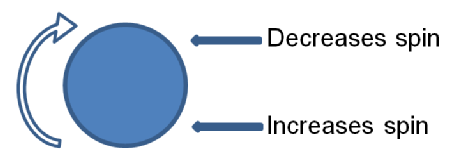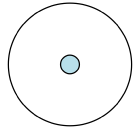(It would help to read the note at the start of Genesis 1a)
Recap:
Our last study (Genesis 1:1-3) covered a quick look at time and eternity, and the creation of the heavens, the earth and light.
Read Genesis 1:1-31
In our previous study we had got as far as verse 3. We recognised that creating light first might be a problem to some – but verses 4 and 5 now compound the problem.
3 And God said, Let there be light, and there was light.
4 God saw that the light was good, and he separated the light from the darkness.
5 God called the light day, and the darkness he called night. And there was evening, and there was morning— the first day.
So it appears that God must have started the Earth spinning. Otherwise, what causes planets and stars to spin (and they all do)? The accepted scientific explanation is that the cloud of material they were made from was already spinning! And that as extra material joined the planet or star, it hit it at an angle that helped the spin!
Although actually, half the material hitting a spinning object should slow down its spin – it just depends where it hits. Also material arriving at a spinning object (bottom arrow) at the same speed as it rotates will have no effect, whereas material arriving and opposing the spin will have a considerable effect (top arrow). So the net effect should be to slow it down!

Interestingly, we are told that the spin of each planet and star is vital to the working of the Universe. It would not be able to exist if everything was stationary. God designed it like that!
Remember that so far the Earth is a smooth ball covered in water. Would that be fresh or salty?
6 And God said, Let there be an expanse between the waters to separate water from water.
7 So God made the expanse and separated the water under the expanse from the water above it. And it was so.
What do verses 6 and 7 mean? What is an Expanse (v8)?
8 God called the expanse sky. And there was evening, and there was morning— the second day.
The next step was to take some of the water that covered the Earth and put it in a canopy or shell round the Earth! Could that conceivably be possible?

It is physically possible. Today there are many satellites in orbit round the Earth at various distances. Geostationary (or Geosynchronous) satellites are roughly 22,236 miles above the Earth (The Earth’s diameter is about 7,926 miles, 24,901 miles circumference).
So a bubble of water could totally enclose the Earth like a greenhouse roof and if it were where these satellites are, 1km of water at the Earth’s surface would form a canopy 16meters thick (although it would probably be frozen solid). (Jupiter’s rings contain much frozen water)
We are not told how much water was put into the canopy, how much was left on the surface of the Earth, or how much was under the surface of the Earth. Calculations indicate that if the Earth were totally smooth, the water currently visible on the surface of the Earth would cover the Earth to a depth of 2.7km. It also seems that up to ten times that amount is contained in rocks in the Earth’s crust.
(http://www.kjvbible.org/geysers.html for more interesting ideas!)
What affect that may have had on the temperature and humidity of the Earth can only be a guess. However we are told in Genesis 2:5-6
5 and no shrub of the field had yet appeared on the Earth and no plant of the field had yet sprung up, for the LORD God had not sent rain on the Earth and there was no man to work the ground, 6 but streams came up from the Earth and watered the whole surface of the ground
The vast oilfields, and coal deposits found all over the Earth, point to conditions that could support worldwide tropical rainforest lushness!
Note also that this water layer could not have been a thick belt of cloud; otherwise the Sun, Moon and Stars would not have been visible. Also from Genesis 13:1 we read that rainbows had not been seen until after the flood, confirming verse 5, that so far there had been no rain.
8 God called the expanse sky. And there was evening, and there was morning— the second day.
People have tried to discover what we should understand by the terms Sky, and Expanse. We see from this verse that they are actually the same thing! To non-scientific people the sky is anything above the Earth. The word for Heaven is not used until Genesis 14:19
and he blessed Abram, saying, “Blessed be Abram by God Most High, Creator of heaven and Earth.
Back to Genesis 1
9 And God said, Let the water under the sky be gathered to one place, and let dry ground appear. And it was so.
10 God called the dry ground land, and the gathered waters he called seas. And God saw that it was good.
Verse 9 suggests that the continents were originally together, and recent geological discoveries have shown similar rocks on the Atlantic coastline in Africa and Brazil. Current thinking is that there was an original land mass which broke up and reformed several times. The most recent rearrangement (called Pangea) could have looked something like this:
 http://commons.wikimedia.org/wiki/File:Pangaea_continents.png
http://commons.wikimedia.org/wiki/File:Pangaea_continents.png
Obviously scooping some of the Earth’s crust to one place could easily (!) provide this – and from now on the Earth would no longer be flat. Note that at each step God inspects the creation, and declares it to be good
11 Then God said, let the land produce vegetation: seed-bearing plants and trees on the land that bear fruit with seed in it, according to their various kinds. And it was so.
12 The land produced vegetation: plants bearing seed according to their kinds and trees bearing fruit with seed in it according to their kinds. And God saw that it was good.
13 And there was evening, and there was morning— the third day.
Remember, the Earth is still the only thing in the Universe. We now come to the creation of the first living matter. And we are specifically told that this was plants and trees bearing seeds. And they were to grow on the land, not in the oceans. It also answers the old question ‘What came first, the chicken or the egg’ or in this case: ‘the plant or the seed?’ It is obvious, the plant came first, but containing in it the DNA necessary to produce seeds.
What soil was there to grow plants in? Perhaps rocks like pumice stone, which is a sponge-like volcanic rock. Pumice has been used as an artificial soil in horticulture.
‘After the explosion of Krakatoa, rafts of pumice drifted through the Pacific Ocean for up to 20 years, with tree trunks floating among them. In fact, pumice rafts disperse and support several marine species. In 1979, 1984 and 2006, underwater volcanic eruptions near Tonga created large pumice rafts, some as large as 30 kilometres that floated hundreds of kilometres to Fiji’ (Wikipedia)
Or actually it could have been anything that God chose! Remember – he is God and cannot be limited.
But plants need heat and light in order to grow, so:
14 And God said, Let there be lights in the expanse of the sky to separate the day from the night, and let them serve as signs to mark seasons and days and years,
15 and let them be lights in the expanse of the sky to give light on the Earth. And it was so.
16 God made two great lights— the greater light to govern the day and the lesser light to govern the night. He also made the stars.
17 God set them in the expanse of the sky to give light on the Earth,
18 to govern the day and the night, and to separate light from darkness. And God saw that it was good.
19 And there was evening, and there was morning— the fourth day.
Only now will the sun be needed. The sun fixed at exactly the right distance from the Earth so that the heat arriving from the sun would allow life to flourish. And without the moon, we would have no tides. (Some people might have a problem with light taking a long time to reach us from a sun 93 million miles away – but at 186,000 miles per second it would only take 8 minutes!)
And the throwaway line at the end of verse 16: He also made the stars. As if it had to be put in somewhere, but wasn’t terribly important! Here the time taken for light to reach the world would be a lot longer – unless God decided that as he was creating it, it would arrive when he chose.
So we get to the end of the fourth day and Heaven and Earth are beginning to look recognisable. No animals, fish or humans yet, but the plants are growing – possibly at an amazing rate in the ‘Greenhouse Effect’ of those early days. Or simply at the speed that God decided! And if they were created with an appearance of age, i.e. fully mature, that too was up to God.
We must always remember that as we try to describe what happened at creation, we are in danger of constraining God to ways and methods known to our limited minds. We constantly need to wonder at the immensity of the power and ability of our amazing God until we run out of superlatives!
I have to say that as I read the first verses of Genesis I am reminded of the words of the Captain of the Star Ship Enterprise, when having discussed the best course of action with his officers, he simply said ‘Make it so’ and verses
7,9,11, and 15 have: And it was so.
As simple as that!





